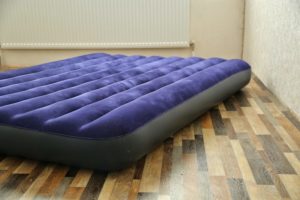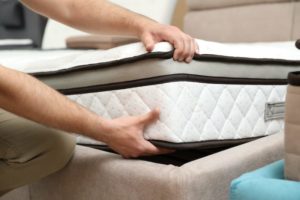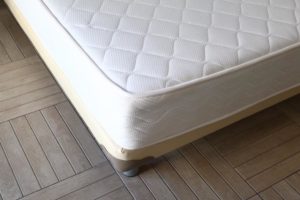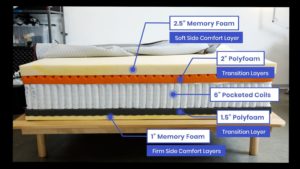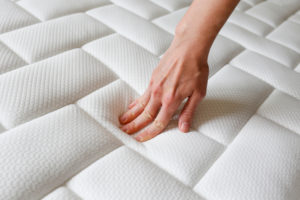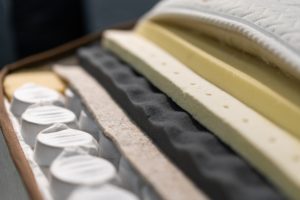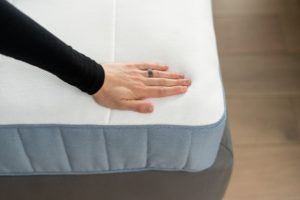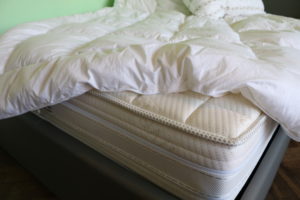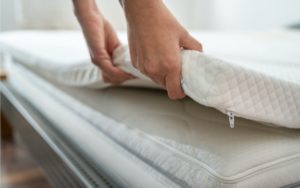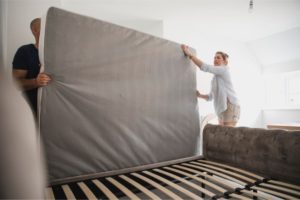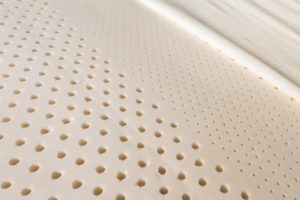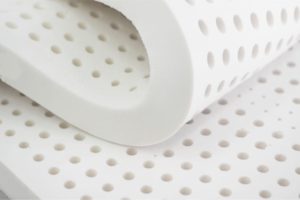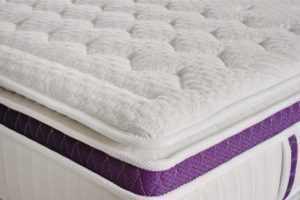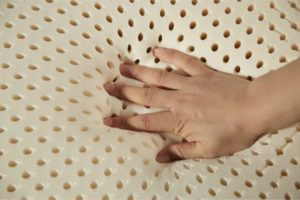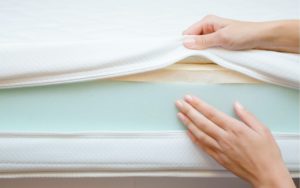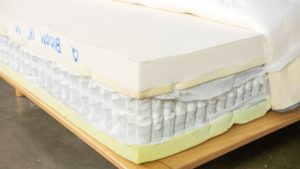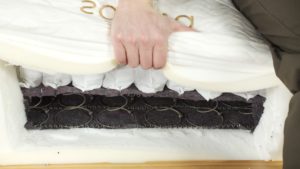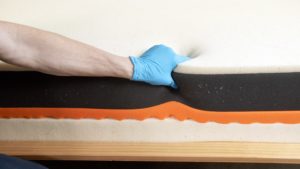How Thick Should a Mattress Be?
Mattress thickness is a critical but often overlooked criterion that influences how a mattress feels and performs. Thicker models have a reputation for luxury, while thinner options tend to be more budget-friendly.
Unfortunately, there’s no simple answer for how thick a mattress should be. Your body weight, sleeping position, and bed frame or foundation height can all shape the ideal profile of your mattress.
We’ll simplify the process by explaining the different thickness categories, who can most benefit from each, and what to consider when choosing a mattress profile.
Mattress Thickness Chart
Because we spend about a third of our lives sleeping, it is important to choose a mattress that is comfortable, durable, and promotes healthy spinal alignment.
Mattresses come in a variety of thicknesses to accommodate varying needs and preferences. To determine which might work for you, consider bed height preferences, mobility issues, body weight, and sleeping position. If you sleep with a partner, you should also factor in their needs to find a comfortable solution for both of you.
| Thickness Range | Description | Best For | |
|---|---|---|---|
| Low Profile | 8 inches or less | Low-profile mattresses are the thinnest type, ranging from around 4 to 8 inches thick. They frequently consist of a support core with a minimal comfort system. They tend to feel firm. | Children can generally use low-profile models comfortably. They also work well on bunk beds and trundle beds. |
| Slim | 8 to 10 inches | A slim mattress usually contains a relatively thin comfort system and support core. | Adults who struggle to get into or out of a higher bed may benefit from a slim mattress. Many children also find them comfortable. |
| Standard | 10 to 12 inches | This is the most common mattress thickness. Standard models typically include a notable comfort system and a durable support core. | Most adults between 130 and 230 pounds are comfortable with this thickness, especially if they sleep on their back. |
| Thick/Deep | 12 to 14 inches | Thick mattresses often balance cushioning and durability thanks to their more generous comfort systems and support cores. | This thickness is typically well suited to sleepers over 230 pounds and side sleepers who need extra pressure relief. |
| Extra Thick/Deep | 14 inches or more | With more room for ample comfort and support systems, extra-thick models tend to feel plush while resisting sagging. However, their height can be difficult to navigate. | An extra-thick mattress may appeal to side sleepers over 230 pounds and anyone looking for enhanced contouring and support. |
Find a Mattress That’s Right for You
Answer these three questions to find a mattress that matches your sleep style.
How to Choose a Mattress Thickness Level
There is no one-size-fits-all mattress. The trick to finding the best mattress with the right height for you is understanding the thickness options and who they work best for.
Low-profile mattresses range from 4 to 8 inches thick. They are most common in situations where a thicker model just won’t fit, such as in bunk beds, trundle beds, and Murphy beds. Children can often sleep comfortably on them. However, we don’t generally recommend low-profile models for adults because they tend to be less supportive, with insufficient pressure relief.
Slim mattresses are 8 to 10 inches thick. While this is thinner than average, it’s thick enough to accommodate many adults. Slim models may be ideal for sleepers who struggle to get into or out of a low bed, such as shorter adults and those with mobility issues. Most children can also sleep comfortably on this thickness.
The standard thickness of 10 to 12 inches is adequate for most average-sized adults. At this height, most models have substantial comfort and support layers. Since this profile is so common, shoppers can select from a wide range of materials, price-points, and firmnesses.
Thick mattresses — also known as deep mattresses — are 12 to 14 inches tall. They typically have a generous comfort layer that offers more pressure relief and contouring while still containing a considerable support core. Since the deeper comfort system leaves more room for a sleeper to sink in, side sleepers and individuals over 230 pounds often prefer thick mattresses. These models also tend to be more durable than average.
Extra-thick mattresses are at least 14 inches tall. Some reach upward of 20 inches. Combining plush comfort layers and a thick support core generally creates a highly durable mattress well suited to sleepers over 230 pounds. However, extremely high-profile models are usually pricier, heavier, and more difficult to set up.
Sleeping Position
Your sleep position influences how much pressure you put on the bed and where that pressure is concentrated. Therefore, it also affects how thick your mattress should be.
Side Sleepers: Side sleepers put more pressure on their shoulders and hips, so they generally need a thicker mattress for adequate pressure relief. Most prefer a model that’s at least 12 inches thick with a substantial comfort layer. A mattress that is too thin is unlikely to let a side sleeper’s shoulders and hips sink in enough, which can lead to pressure buildup and poor posture.
Back Sleepers: Back sleeping often leaves a gap between the lower back and the mattress, which can create extra tension in the lumbar area. A mattress between 10 and 12 inches thick that provides some contouring without sagging can help support the natural curvature of a back sleeper’s lower spine.
Stomach Sleepers: Stomach sleepers are vulnerable to lower back strain if their midsections sink in too deeply. They should typically look for a mattress around 10 inches thick with enough support to prevent their spines from bending into a U-shape. A taller model may also be suitable if it has a relatively thin comfort system.
Combination Sleepers: As the name implies, combination sleepers change positions throughout the night, meaning they need a versatile mattress that can accommodate different positions. In general, a 12-inch mattress should have a good balance of cradling and support.
Body Weight
Body weight is just as important as sleep position when choosing a mattress thickness. Sleepers who weigh more sink into a mattress more deeply than lighter individuals and generally need the added support of a thicker mattress.
Sleepers Under 130 Pounds: Thin mattresses often feel too firm for sleepers under 130 pounds. They are traditionally more comfortable on a model at least 12 inches thick with a generous comfort system that offers significant pressure relief and contouring. However, young children can easily use thinner foam mattresses, such as those commonly found in bunk beds.
Sleepers Between 130 and 230 Pounds: This weight range encompasses most average-sized adults. A mattress that is 10 to 12 inches thick is usually sufficient. However, your sleeping position and the mattress materials may also influence the ideal thickness.
Sleepers Over 230 Pounds: Because they sink in more deeply, sleepers over 230 pounds generally favor a mattress at least 12 to 14 inches thick. They typically need a thicker comfort system and a sturdy support core to contour to their bodies without sagging.
Number of Sleepers
If you sleep with a partner or a child, finding a mattress thickness that suits both of you is inherently more complicated. Couples need a mattress that’s thick enough to support their combined weights and durable enough to last.
You should also consider your preferred sleeping positions. Anyone sharing a bed should look for a mattress at least 10 inches thick. Thinner models are more likely to sag under your combined weight. Sleep partners who both weigh over 230 pounds often need an extra-thick mattress for sufficient support.
Bed Base Height
Consider the height of your bed base when shopping for a mattress. If you’re using a bed frame and a box spring, an extra-thick mattress may be challenging to climb into. At the same time, a thin mattress paired with a low-rise platform bed may seem too close to the ground.
You should be able to sit comfortably on the edge of the bed with your feet resting on the ground. This makes getting in and out of bed much easier, especially for those with limited mobility. Keep in mind that many mattresses and bed frames don’t require a box spring.
What Determines Mattress Thickness?
Mattress thickness is determined primarily by the heights of the bed’s main components: the comfort system and the support core.
The comfort system consists of the layer or layers closest to your body. It’s the softest part of the bed designed to provide pressure relief, contouring, and motion isolation. Most comfort layers are 1 to 4 inches thick. Thinner comfort layers are more common in firmer models, while softer options usually have thicker comfort systems.
The support core is at the base of the mattress and generally comprises half to two-thirds of the thickness. It provides overall support and prevents sleepers from sinking too far into the surface. In general, a thicker support core makes a mattress more durable.
Frequently Asked Questions
We’ll answer some of the most common thickness-related questions that shoppers have while searching for their ideal mattress.
While most sleepers prefer a mattress that’s at least 10 inches thick, mattress thickness depends on personal needs and preferences. A thicker mattress may be better for side sleepers, individuals over 230 pounds, and those who find it easier to get in and out of a higher sleep surface.
The average mattress ranges from 8 to 14 inches tall, which includes slim, standard, and thick mattresses. A standard thickness of 10 to 12 inches can accommodate most adults.
The thickness of your mattress can affect what bedding you need. If you choose a thick or an extra-thick mattress, you may need deep pocket or extra-deep pocket sheets designed to fit higher-profile models. The packaging or product description should mention the pocket depth, which clarifies how thick a mattress the fitted sheet accommodates.
A mattress’ thickness can affect its longevity. Thicker support cores tend to resist sagging, which can extend the usable life of the mattress. Ideally, the core should make up at least 50% of the mattress thickness. Models with quality foam or pocketed coil cores can last up to 10 years. Low-profile mattresses with thinner cores are more likely to sag and break down prematurely.

Still have questions? Ask our community!
Join our Sleep Care Community — a trusted hub of sleep health professionals, product specialists, and people just like you. Whether you need expert sleep advice for your insomnia or you’re searching for the perfect mattress, we’ve got you covered. Get personalized guidance from the experts who know sleep best.







